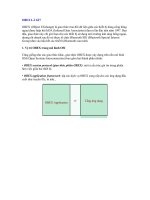Tài liệu GR-1089 HDSL A3 VOLTAGE ppt
Bạn đang xem bản rút gọn của tài liệu. Xem và tải ngay bản đầy đủ của tài liệu tại đây (234.02 KB, 4 trang )
GR-1089 HDSL A3 V
OLTAGE
T
ECHNICAL
B
RIEF
HDSL is a powerful, cost-effective, T1-based transport technology that
leverages existing copper infrastructure and is, therefore, of great interest to
both subscribers and service providers. It uses central office (CO) units at the
carrier's office and remote units at the customer site and may, depending
upon distance, require HDSL repeaters over the length of the copper span.
The power needed to operate the repeaters and remote equipment is provided
over the span itself, and must be handled safely for the protection of users
and telephone company craftspersons.
Nobody cares more about the safety of telecommunications equipment than
ADC Telecommunications, but when it comes to setting safety standards, the
industry turns to Bellcore. GR-1089 is a detailed Bellcore specification
covering, among other things, safe powering of facilities. Section 7 of the
document defines levels of allowable electrical currents and voltages which
may be applied to circuits and equipment, depending on who will have access
to the equipment.
• Class A1 is the most stringent and applies to areas which may be
contacted by the general public, which is assumed to be unfamiliar
with electrical hazards.
• Class A2 permits higher limits and covers those areas where
non-specialized telephone company employees may have contact.
• Class A3 is the highest allowable level for voltages which may be
contacted barehanded. It applies to those areas available only to
telephone company craftspersons familiar with the appropriate
precautions, and applies to HDSL circuits and equipment.
Introduction
Setting
Standards
24/98 2
436
GR-1089 HDSL A3 Voltage Technical Brief
The A3 standard covers both DC and AC voltages; however, only DC applies to HDSL
equipment. According to section 7.2.1 of the GR-1089 standard, the limits apply “be-
tween each terminal and ground with all other terminals first open-circuited, and then
with all other terminals individually grounded.” “Terminal” refers to any HDSL wire
pair. “Grounded” terminals are in contact with any conductor — a metal case, for
example — with which a craftsperson could come in contact.
This standard is designed to protect craftspersons both against electrical flows in
individual circuits and against combined voltages in the event that one set of terminals
becomes accidentally grounded, for example by having insulation pinched in the door of
an enclosure. The risk at these levels is not just electrocution. It is the muscle spasms
caused by the current flow, which can cause pulled backs, falls, or other dangerous
accidents.
The A3 standard, in section 7.2.1.3, sets limits on both voltage and current. At 140V or
less, there is no limit on current. Between 140V and 200V, current may not exceed
10mA. In no event may voltage exceed 200V. All of these voltages are measured with
respect to ground. (See graph)
A3 Defined
I
dc
(mA)
0246810121416
200
175
150
125
100
75
50
25
0
VDC (v)
(10mA, 200V)
(10mA, 140V)
DC ONLY
UNACCEPTABLE
ACCEPTABLE
These are simply standards and do not have the force of law. They are, however, the best
available guidelines for protection of personnel who come in contact with equipment.
Since manufacturers are not required to follow them, it is up to concerned buyers to
check for compliance.
Some confusing references to the GR-1089 standard have been made recently in the
marketplace. Some of these appear to be worded specifically to mislead, and have gone
so far as to imply — without actually stating so — that one vendor’s approach to HDSL
powering is the only one compliant with GR-1089.
3
4/98 3
436
GR-1089 HDSL A3 Voltage Technical Brief
There are two ways to meet GR-1089’s A3 standard for voltages under 140V. One is to
provide a single compliant voltage, for example -130V. The other is to provide two
separate, compliant voltages, one at -130V, the other at +130V, providing twice the
voltage for powering the HDSL span. The +/-130V technique has been used to power
long T1 spans since the 1960s, and has a excellent record for safety. Bellcore’s standard
specifically tests for the safety of this approach (by requiring that each terminal be
tested “...with all other terminals individually grounded.”)
The requirement for testing with “terminals individually grounded” simulates accidental
grounding of a circuit within the span or equipment. Compliance with this requirement
ensures that, even with twice the available voltage to the line and equipment, the 140V
limit cannot be exceeded, even through accidental grounding. This allows craftspersons
to handle the equipment with no more risk than if only a single voltage were present.
The problem with the first approach — a single voltage at -130V — is that, while it is
safe, it greatly limits the distance over which HDSL can be provided. 130 volts is only
capable of powering a single repeater and the remote equipment. The second approach
— two separate sources at +/-130V — allows support of remote equipment and two
repeaters, increasing the maximum span length by 50 percent. As long as it meets the
“terminals individually grounded” test, it does so with no sacrifice in safety. ADC’s HDSL
terminal equipment uses this second approach. The long history of safe use of +/-130V
for powering longer T1 spans was instrumental in the company’s decision.
All the Safety With
Twice the Voltage
ADC equipment is carefully designed to meet Bellcore’s requirement for testing each
terminal with the other “terminals individually grounded” and, in doing so, provides
full protection to personnel as well as increased electrical potential to power longer
spans. This is achieved in the design of the connection between the power supply center
tap and ground. The connection is specifically engineered with sufficiently low imped-
ance that grounding any tip or ring terminal will cause that power supply output to go
into protective shutdown. This allows the system to power two repeaters per span, fully
complies with the Bellcore GR-1089 requirements, and protects craftspersons working
with the equipment.
How it’s Done
In Summary
•Despite any suggestions to the contrary, the Bellcore GR-1089 specification has no
preference for -130V over +/-130V span powering, as long as the requirement for
testing with “terminals individually grounded” is met.
•Any service which can be provided under -130V power without powering down the
local loop can be similarly provided under compliant +/-130V power.
•Despite suggestions to the contrary, you don’t have to sacrifice longer HDSL
span-length to achieve full safety for your field personnel.
•For your own protection and that of your personnel, you should ascertain that your
HDSL equipment meets GR-1089 specifications. Not all equipment being sold today
does. Include compliance in your specifications and be prepared to test, if necessary.
ADC is committed to performance and safety in everything we sell. We will never
sacrifice safety, but we believe that, through superior engineering, we can provide our
customers with both.
436 4/98 Revision © 1997, 1998 ADC Telecommunications, Inc. All Rights Reserved An Equal Opportunity Employer
Specifications published here are current as of the date of publication of this document. Because we are continuously improving our products,
ADC reserves the right to change specifications without prior notice. At any time, you may verify product specifications by contacting our
headquarters office in Minneapolis. ADC Telecommunications, Inc. views its patent portfolio as an important corporate asset and vigorously
enforces its patents. Products or features contained herein may be covered by one or more U.S. or foreign patents.
ADC Telecommunications, Inc.
P.O. Box 1101
Minneapolis, Minnesota 55440-1101
FAX: +1(612) 946-3292
From North America, Call Toll Free: 1-800-366-3891, ext. 3223
Outside of North America: +1(612) 938-8080
Home Page Address:
International Sales Offices: Belgium 32-2-712-6500 • United Kingdom 44-11-89-879-
200 • Montreal, Quebec (514) 677-9166 • Vancouver, BC (604) 270-1675 • Toronto, Ont.
(905) 629-3104 • Ottawa, Ont. (613) 599-5729 • Singapore 65-225-8228 •Venezuela 58-
2-286-1444 • Mexico City, Mexico 525-658-4519 • Buenos Aires, Argentina (541) 788-
8700 • Sao Paulo, Brasil 55-11-3040-0666 • Sydney, Australia 61-2-9975-1499 •
Beijing, China 86-10-6500-7001 • Dusseldorf, Germany 49-211-530-6550 • Seoul,
Korea 82-2-333-8989









